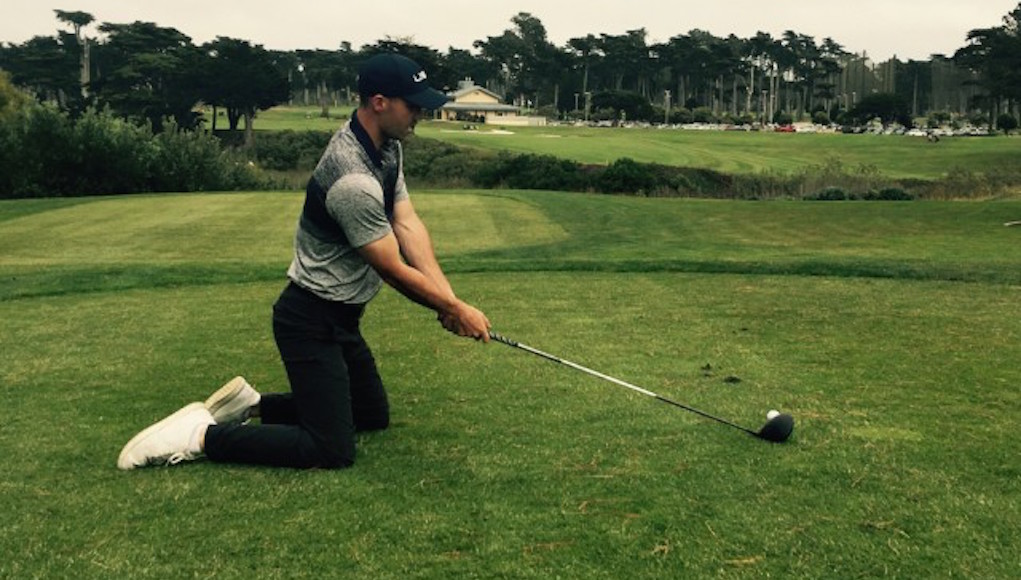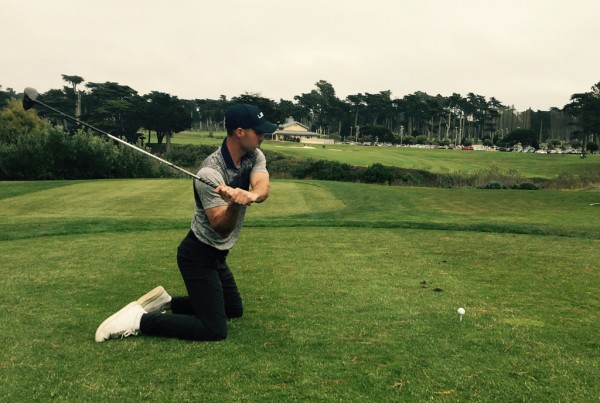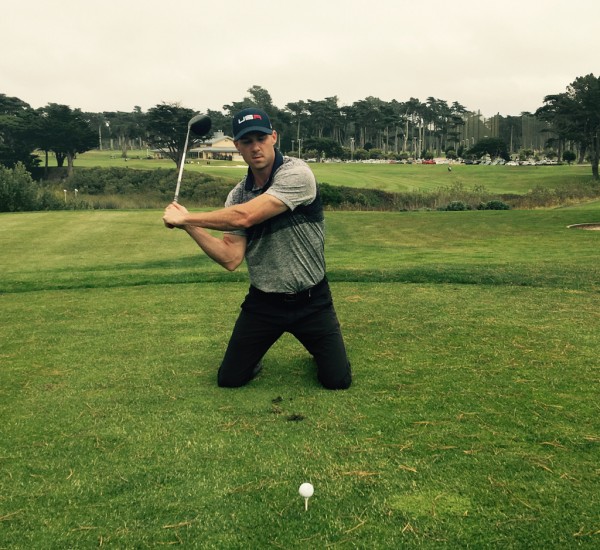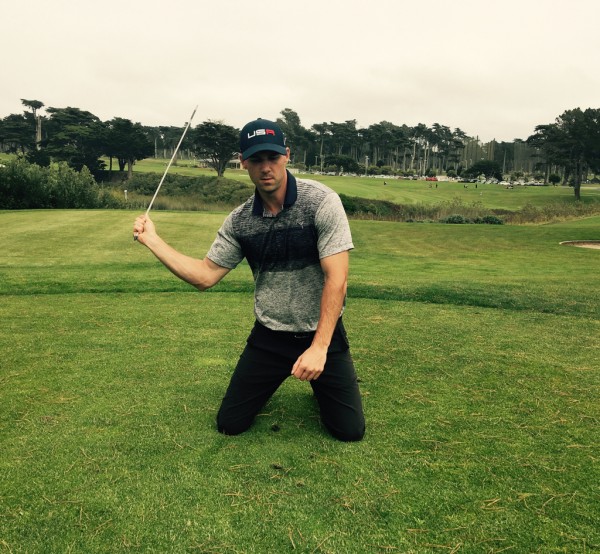Instruction
Why hitting drivers off your knees is the best drill for your swing

Growing up in a small, rural town, I didn’t have access to a lot of instruction, nor was it easily available. Sites like GolfWRX weren’t around at the time. Being fascinated with the golf swing at an early age, I had to rely on trial and error with my own swing, an old-school camera and the once-a-month Golf Digest issue.
Every month, I would scan that Golf Digest for tips from the best golfers and golf instructors in the world. The names changed, but the same old instruction was often given in the write ups. I would constantly try to mirror the images of what I saw, following the tips to gain more power and to be more consistent.
Then there was our PGA Teaching Professional at our local golf course. The 10th hole at our local muni had a creek running across the fairway, a good 230 yards out. Usually with a few spectators on hand, Tad would tee up a ball, place a towel on the ground and proceed to hit a driver from his knees, clearing the creek with ease. At first sight, it was simply hard to believe. Many bets were won with that swing.
Already being a student of the swing, this left me confused. How could he create so much speed and power from that position? Everything I read told me that power came from a “big shoulder turn” on the backswing and “firing my hips” on the downswing.
At the time, I thought my local PGA pro had mastered a trick-shot. Now I realize that hitting drivers off your knees, or just swinging from your knees, is the best drill for your golf swing and can instantly change your game.
Here’s why.
When you swing the club from your knees, it forces you to turn your upper body in the proper direction and maintain your spine angle. The best way to make contact is to fold up your right arm, which will pull your body into the proper coil position behind the ball. Simply folding up your right arm will pull your shoulders around, so a conscious, big shoulder turn is not necessary.
To a player who doesn’t turn in the proper direction, swinging from your knees will feel more around or level with the shoulders at first. “Tilters” as I call them, or players whose spines tend to move toward the target on their backswing, will not be able to make contact doing this drill. They will feel like they are hitting well behind the ball when attempting to swing, and will be forced to adjust.
Swinging from your knees is also a great drill to produce speed, especially arm speed. Being down in this position will stabilize your body, getting rid of extra moving parts. Now you can generate shaft speed with your arms.
Anytime we can limit extra moving body parts in the golf swing, we have a greater chance to produce speed and consistency. A longer swing does not mean more speed and is usually a false sense of power. In the video below, former Re-Max Long Drive Champion Jamie Sadlowski hits a golf ball 331 yards from his knees.
For players who battle the dreaded “over-the-top” move, which causes a weak ball flight, feeling how your right arm works throughout this drill (for a right-handed golfer) will give you instant feedback on how your right arm should work both on the backswing and downswing. A tucked, right arm on the downswing is a key move for delivering a powerful inside path to the ball.
Again, in order to make contact with the ball from on your knees, your right arm must stay tucked in on the downswing, which is a must to keeping the shaft shallow (show below) and will help produce a draw ball flight.

If you are not ready to give the driver off the knees a try or don’t feel comfortable doing the drill at your local range, try practicing with an alignment stick with no ball as shown below. Take your stance from your knees and practice swinging the alignment stick with your right arm only. Work on building up speed and you will still get the feeling of how your arms and body work throughout the drill. You will notice how much speed you can generate from such a small limited move.
- LIKE444
- LEGIT38
- WOW14
- LOL8
- IDHT6
- FLOP7
- OB5
- SHANK29
Instruction
Clement: Laid-off or perfect fade? Across-the-line or perfect draw?

Some call the image on the left laid off, but if you are hitting a fade, this could be a perfect backswing for it! Same for across the line for a draw! Stop racking your brain with perceived mistakes and simply match backswing to shot shape!
- LIKE0
- LEGIT0
- WOW0
- LOL0
- IDHT0
- FLOP0
- OB0
- SHANK1
Instruction
The Wedge Guy: The easiest-to-learn golf basic

My golf learning began with this simple fact – if you don’t have a fundamentally sound hold on the golf club, it is practically impossible for your body to execute a fundamentally sound golf swing. I’m still a big believer that the golf swing is much easier to execute if you begin with the proper hold on the club.
As you might imagine, I come into contact with hundreds of golfers of all skill levels. And it is very rare to see a good player with a bad hold on the golf club. There are some exceptions, for sure, but they are very few and very far between, and they typically have beat so many balls with their poor grip that they’ve found a way to work around it.
The reality of biophysics is that the body moves only in certain ways – and the particulars of the way you hold the golf club can totally prevent a sound swing motion that allows the club to release properly through the impact zone. The wonderful thing is that anyone can learn how to put a fundamentally sound hold on the golf club, and you can practice it anywhere your hands are not otherwise engaged, like watching TV or just sitting and relaxing.
Whether you prefer an overlap, interlock or full-finger (not baseball!) grip on the club, the same fundamentals apply. Here are the major grip faults I see most often, in the order of the frequency:
Mis-aligned hands
By this I mean that the palms of the two hands are not parallel to each other. Too many golfers have a weak left hand and strong right, or vice versa. The easiest way to learn how to hold the club with your palms aligned properly is to grip a plain wooden ruler or yardstick. It forces the hands to align properly and shows you how that feels. If you grip and re-grip a yardstick several times, then grip a club, you’ll see that the learning curve is almost immediate.
The position of the grip in the upper/left hand
I also observe many golfers who have the butt of the grip too far into the heel pad of the upper hand (the left hand for right-handed players). It’s amazing how much easier it is to release the club through the ball if even 1/4-1/2″ of the butt is beyond the left heel pad. Try this yourself to see what I mean. Swing the club freely with just your left hand and notice the difference in its release from when you hold it at the end of the grip, versus gripping down even a half inch.
To help you really understand how this works, go to the range and hit shots with your five-iron gripped down a full inch to make the club the same length as your seven-iron. You will probably see an amazing shot shape difference, and likely not see as much distance loss as you would expect.
Too much lower (right) hand on the club
It seems like almost all golfers of 8-10 handicap or higher have the club too far into the palm of the lower hand, because that feels “good” if you are trying to control the path of the clubhead to the ball. But the golf swing is not an effort to hit at the ball – it is a swing of the club. The proper hold on the club has the grip underneath the pad at the base of the fingers. This will likely feel “weak” to you — like you cannot control the club like that. EXACTLY. You should not be trying to control the club with your lower/master hand.
Gripping too tightly
Nearly all golfers hold the club too tightly, which tenses up the forearms and prevents a proper release of the club through impact. In order for the club to move back and through properly, you must feel that the club is controlled by the last three fingers of the upper hand, and the middle two fingers of the lower hand. If you engage your thumbs and forefingers in “holding” the club, the result will almost always be a grip that is too tight. Try this for yourself. Hold the club in your upper hand only, and squeeze firmly with just the last three fingers, with the forefinger and thumb off the club entirely. You have good control, but your forearms are not tense. Then begin to squeeze down with your thumb and forefinger and observe the tensing of the entire forearm. This is the way we are made, so the key to preventing tenseness in the arms is to hold the club very lightly with the “pinchers” — the thumbs and forefingers.
So, those are what I believe are the four fundamentals of a good grip. Anyone can learn them in their home or office very quickly. There is no easier way to improve your ball striking consistency and add distance than giving more attention to the way you hold the golf club.
More from the Wedge Guy
- The Wedge Guy: Golf mastery begins with your wedge game
- The Wedge Guy: Why golf is 20 times harder than brain surgery
- The Wedge Guy: Musings on the golf ball rollback
- LIKE87
- LEGIT13
- WOW6
- LOL1
- IDHT0
- FLOP4
- OB1
- SHANK8
Instruction
Clement: Stop ripping off your swing with this drill!

Not the dreaded headcover under the armpit drill! As if your body is defective and can’t function by itself! Have you seen how incredible the human machine is with all the incredible feats of agility all kinds of athletes are accomplishing? You think your body is so defective (the good Lord is laughing his head off at you) that it needs a headcover tucked under the armpit so you can swing like T-Rex?
- LIKE0
- LEGIT2
- WOW2
- LOL0
- IDHT0
- FLOP0
- OB0
- SHANK2
-

 19th Hole2 weeks ago
19th Hole2 weeks agoDave Portnoy places monstrous outright bet for the 2024 Masters
-

 19th Hole4 days ago
19th Hole4 days agoJustin Thomas on the equipment choice of Scottie Scheffler that he thinks is ‘weird’
-

 19th Hole2 weeks ago
19th Hole2 weeks agoTiger Woods arrives at 2024 Masters equipped with a putter that may surprise you
-

 19th Hole4 days ago
19th Hole4 days ago‘Absolutely crazy’ – Major champ lays into Patrick Cantlay over his decision on final hole of RBC Heritage
-

 19th Hole2 weeks ago
19th Hole2 weeks agoTwo star names reportedly blanked Jon Rahm all week at the Masters
-

 19th Hole1 week ago
19th Hole1 week agoReport: LIV Golf identifies latest star name they hope to sign to breakaway tour
-

 19th Hole2 weeks ago
19th Hole2 weeks agoNeal Shipley presser ends in awkward fashion after reporter claims Tiger handed him note on 8th fairway
-

 19th Hole1 week ago
19th Hole1 week agoBrandel Chamblee has ‘no doubt’ who started the McIlroy/LIV rumor and why


















Pingback: How golf should be learned – GolfWRX
Pingback: What you can learn from Steve Elkington – GolfWRX
jacob
Sep 29, 2016 at 12:09 am
Great article…try it …
WayneKing
Sep 27, 2016 at 1:45 pm
Those them curry life alert shoes?
You ever made over the creek on 10 at ukiah?
BSGolf
Sep 26, 2016 at 4:13 pm
Kevin Kelly responsible for drivers breaking at the hosel across the nation…
Adam
Sep 28, 2016 at 5:13 pm
Who is Kevin?
Harry Smallwood Slavin
Sep 28, 2016 at 9:13 pm
Green Jacket, Gold Jacket who gives a $hit
Mr. Wedge
Sep 26, 2016 at 1:58 pm
I had an instructor who made me do this once, but didn’t really explain why and maybe that’s why I didn’t keep trying. Might try it into a net at home. I’d hate to do this in public at the range.
Dave C
Sep 26, 2016 at 1:31 pm
It would be nice if the video was attached so we could watch it!
JStan
Sep 26, 2016 at 3:40 am
Great drill. Is that Presidio? Sure looks like it.
Lowell
Sep 26, 2016 at 10:37 am
Looks like number 18 at Harding Park to me JStan. 18 at Presidio is that Long Straight par 5. Both are beautiful courses.
KoreanSlumLord
Sep 25, 2016 at 4:28 pm
This drill was often used by Ben Hogan and Jack Nicklaus on the practice tee.